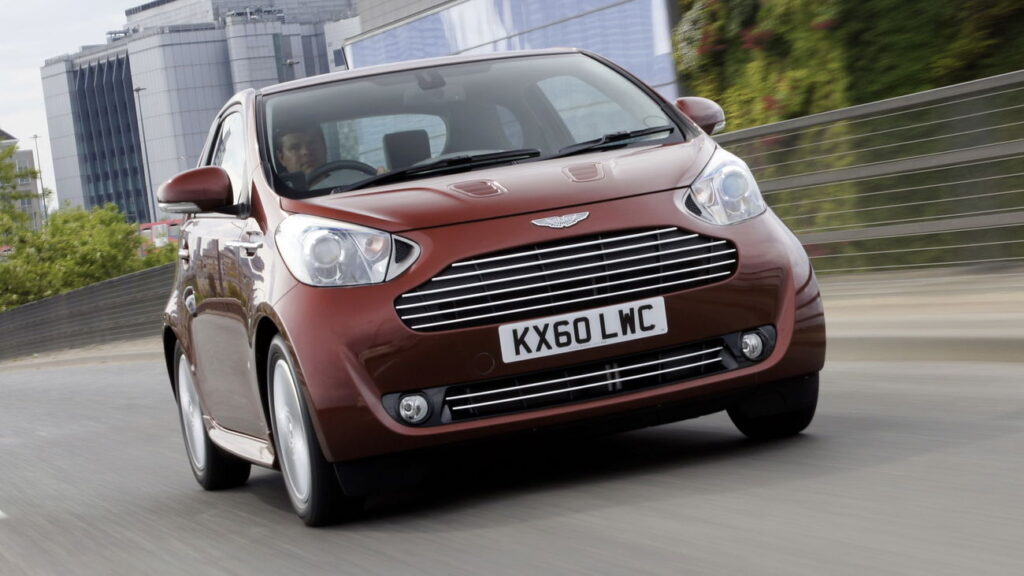Sometimes, when a car company wants a new addition to its range on the cheap, it’ll turn to another manufacturer – whether one that’s part of the same group or just as a one-time thing – and slap some different badges and a new name on an existing car. This is a process known as badge engineering, although the word ‘engineering’ is rather overselling it.
Mostly, the results are pretty unremarkable. Occasionally, you get something brilliant like the Vauxhall Monaro. Quite often, though, they’re just plain weird. Here are 10 of the oddest examples of rebadged cars in history.
Aston Martin Cygnet
Aston Martin Cygnet
Where else could we begin? Conceived as a way to get Aston Martin’s fleet emissions down to comply with then-upcoming European rules, the Cygnet was a truly bizarre thing: a tiny Toyota iQ city car, complete with a mighty 1.3-litre, 97bhp engine, with an Aston grille and lights crudely slapped onto it and a load of leather on the inside.
Launched in 2011, the idea was apparently hatched when then-Aston boss Ulrich Bez met Toyota chairman Akio Toyoda at a late night party at the Nürburgring 24 Hour race. It all starts to make a lot more sense, really, when you consider that it was probably the product of sleep deprivation and quite possibly some adult beverages. On sale at more than three times the price of an iQ, the Cygnet was unsurprisingly a flop, with only around 786 built during its two-year production run.
Subaru Traviq
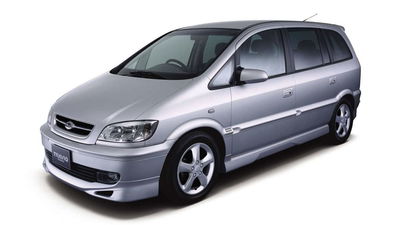
Subaru Traviq
Think Subaru, and you’ll either think of rugged, rufty-tufty all-wheel drive workhorses or burbly, bewinged blue-and-gold rally heroes. What you probably won’t picture is a Vauxhall Zafira.
The Subaru Traviq, though, came about because in the early noughties, General Motors, which owned Opel and Vauxhall, also held a stake in Subaru’s parent company, Fuji Heavy Industries. Sold between 2001 and 2004, creating the Traviq involved slapping Subaru badges and a funky bodykit on Thai-built examples of the Zafira people carrier and sending them over to Japan, providing a handy MPV addition to Subaru’s range (although the Opel Zafira was already sold there).
Kia Elan
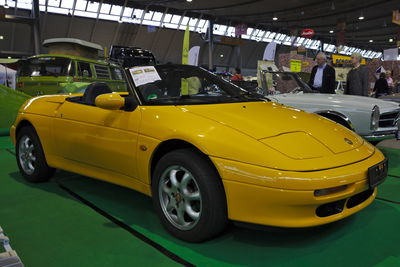
Kia Elan
The reborn front-wheel drive Lotus Elan, launched in 1989, was never a true classic of the roadster genre, largely because it arrived right around the same time as a little thing called the Mazda MX-5. It did have an unexpected second life after production wrapped up in 1995, though.
The production rights were sold to Kia, and the tooling shipped from Norfolk to South Korea, giving the rapidly-growing manufacturer a shortcut to a sporty addition to its lineup. The original’s Isuzu engine was ditched for one of Kia’s own, a 1.8-litre which, ironically enough, had its roots in a Mazda design. Around 1000 were built, all for South Korea and Japan.
Image: Alexander Migl, CC BY-SA 4.0
Cadillac Catera
In the 1990s, Cadillac, once a dominant force in the premium segment in the US, was facing ever-growing competition from European and Japanese manufacturers. Caddy took the approach of ‘if you can’t beat ’em, join ’em’, sourcing a European saloon to badge as its very own.
Unfortunately, the saloon it picked was the Vauxhall/Opel Omega. This made sense, given both brands were part of the GM empire, and the Omega wasn’t a completely terrible car, but it was never really cut out to go head-to-head with the likes of the BMW 3 Series and Lexus IS, especially with the Catera’s only powertrain option a weedy 200bhp V6 linked to a four-speed auto. A wantonly bizarre ad campaign featuring a cartoon bird and the tagline ‘the Caddy that zigs’ couldn’t rescue it from mediocrity.
Saab 9-2X
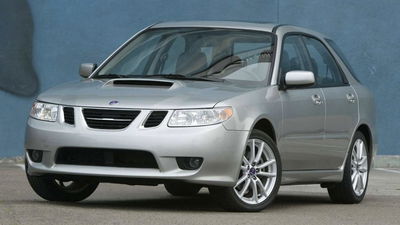
Saab 9-2X
Like the Traviq, the Saab 9-2X was a product of Subaru’s GM connection, although this time, it was Subie lending one of its cars to a brand owned by the American giant. Lacking a compact car in its North American lineup, Saab was able to cut a corner by borrowing the Impreza estate.
While there was a basic naturally-aspirated version available, the one you’re probably interested in is the 227bhp turbocharged Aero, which was effectively an Impreza WRX with a Saab-ish face. Saab also tweaked the suspension, fitted the quicker steering rack from the Impreza STI, and improved the Subie’s less than stellar levels of refinement. All in all, it’s an oddly appealing package, but the Saabaru was a sales phenomenon and only lasted two years on the market.
Bertone Freeclimber
.jpg)
Bertone Freeclimber
Best known as a styling house responsible for some of the most spectacular car designs in history (and also the Daewoo Espero), Bertone has on occasion sold cars under its own name.
One of these was the Freeclimber, an Italian-built version of the Daihatsu Fourtrak, of all things. In addition to some subtle styling tweaks and a (slightly) plusher interior, the Fourtrak’s range of four-cylinder engines were swapped out for a series of petrol and diesel BMW straight-sixes. So yes, this is a Daihatsu, built in Italy, and fitted with BMW engines. Truly, one of the biggest curiosities in automotive history.
Image: Spanish Coches, CC BY 2.0
Lancia Thema
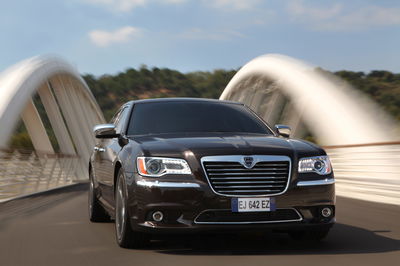
Lancia Thema
The original Lancia Thema of the 1980s shared its underpinnings with Alfa Romeo, Fiat and Saab, but at least had its own visual identity. The second generation from the early 2010s wasn’t so lucky. It was a product of the early 2010s, when what was then the Fiat-Chrysler group was trying to give its two most neglected brands – Chrysler and Lancia – a leg up by letting them share each others’ cars.
This led to some pretty weird results, with the Lancia Delta and Ypsilon being sold with Chrysler badges in Britain, but it was arguably even stranger in mainland Europe: the second-generation Chrysler 300C ended up having Lancia logos and a badge from the ’80s slapped on it. Unsurprisingly, this didn’t make much of an impact, and the Chrysler-Lancia experiment ended soon after, although both brands are still under the shared ownership of Stellantis.
Daewoo G2X

Daewoo G2X
Daewoo, then the South Korean division of General Motors, was never exactly a brand famed for its sportiness, but being part of GM meant it had a quick way into a sports car for its home market.
It took the Saturn Sky roadster (itself a lightly restyled Pontiac Solstice), stuck some Daewoo badges on it and called the result the G2X. With a 2.0-litre turbocharged engine making 260bhp, it was quite a rapid little thing, although unlike the Sky, it only came with an automatic gearbox. Apparently, only 179 were built. The Sky was also rebadged for mainland Europe as the Opel Speedster, although never in Britain as a Vauxhall, despite the promising VX Lightning concept.
Mazda Roadpacer AP
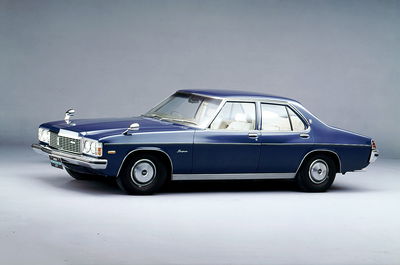
Mazda Roadpacer AP
In the 1970s, Mazda wanted a big executive saloon to sell in Japan. Rather than build its own, though, it struck a deal with GM, which at the time was keen to know more about the lightweight rotary engines Mazda had championed.
The result was the Roadpacer AP, which was essentially a Kingswood, from GM’s Australian Holden division, with its 3.3-litre straight-six swapped out for a 1.3-litre 13B rotary. The rotary was about as powerful as the big six, but only had around half the torque, which was a problem in the big, heavy Kingswood. It also meant that despite Mazda touting the rotary’s low-emissions credentials (AP stood for Anti-Pollution), the engine was spectacularly overworked in the Roadpacer, burning through fuel at a staggering rate.
VW 1500

VW 1500
For a car that’s largely forgotten about these days, the little Hillman Avenger – a Ford Escort rival from Britain’s now-defunct Rootes Group – lived a remarkably long life with many different identities. In Europe alone, it was sold first as a Hillman, then a Chrysler, then a Talbot. North America got it as the Plymouth Cricket, and it was badged as a Dodge in various parts of South America.
The strangest iteration, though, came in Argentina in 1982. When Chrysler closed its South American division, Volkswagen bought up what was left, including the tooling for the local Dodge-badged version of the Avenger. It relaunched it as the VW 1500, which – fun fact – was one of a tiny handful of VW-badged vehicles to ever be front-engined, rear-wheel drive.
Read the full article here


